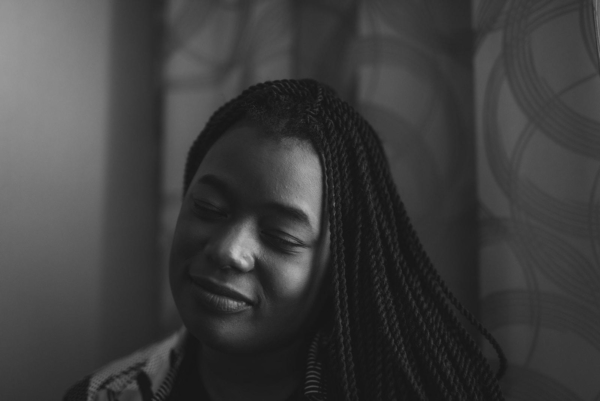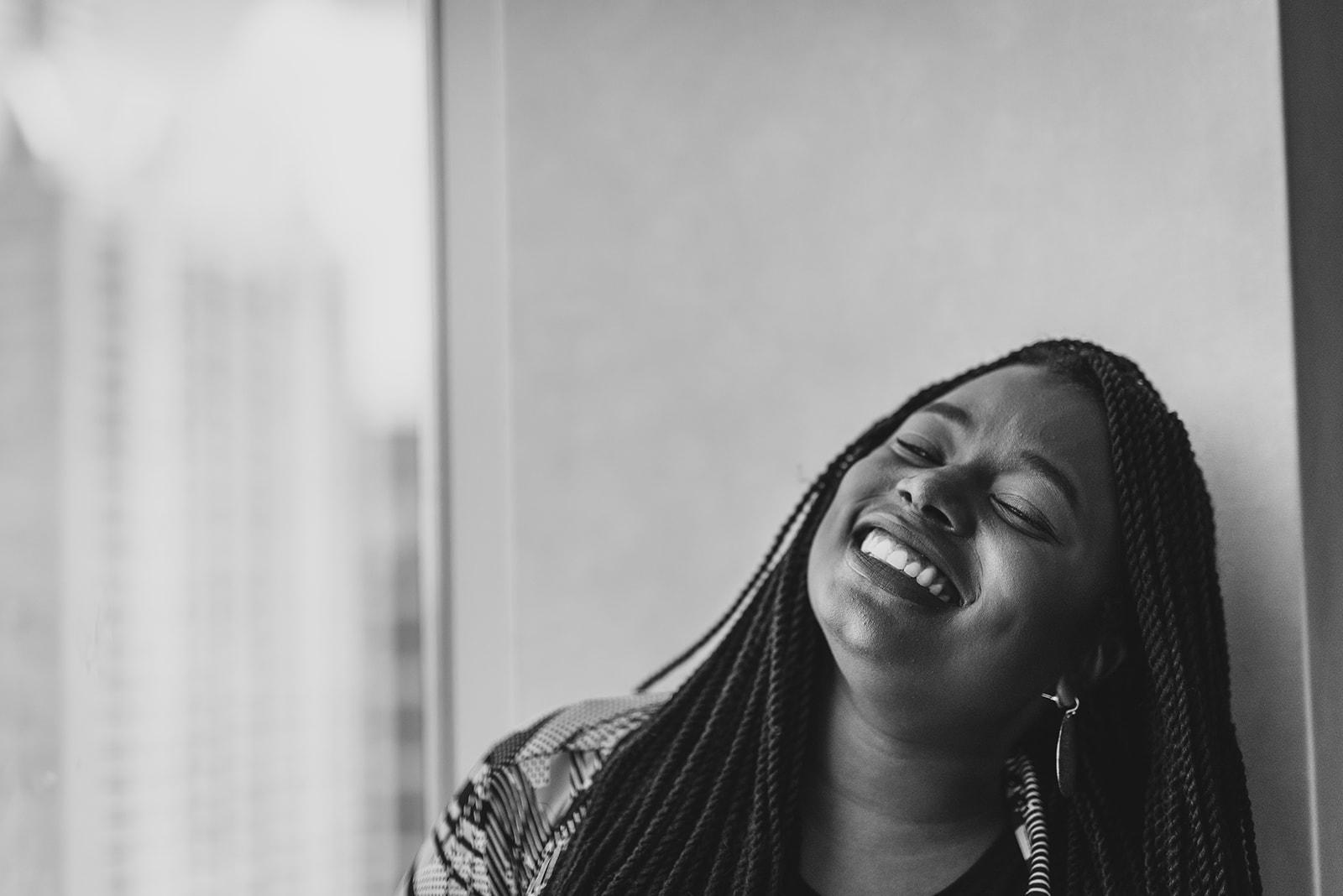
Teonna’s Story
Patient Voices
Teonna
Sickle Cell Disease
Baltimore, Maryland | Born July 1991
“In spite of everything, I am still able to smile.”
Above the towering buildings that frame the Houston skyline, heavy grey clouds move across the city, bringing the promise of rain. Teonna turns her face toward the breeze, allowing the wind to blow her skirt in billowing waves behind her. She delights in it all––the view from the hotel balcony, the fresh air, and a short break from the intensive work she has been engaged in since early morning. Teonna, who lives in Baltimore, is in Houston to attend the Living Rare, Living Stronger National Organization for Rare Diseases (NORD) Patient and Family Forum, a large-scale conference that serves the rare disease community. As a patient advocate, she often serves on panels to speak about sickle cell disease (SCD), but at this conference, she is here to network and informally represent her community of fellow “sickle cell warriors,” whom she describes as “the most resilient group of people I have ever met.” Her remarkable story, built on a lifetime of overcoming inconceivable odds, is the foundation for her work as a patient advocate and an inspiration to those fortunate enough to hear her tell it.
Teonna was diagnosed with SCD as an infant, following a routine screening at the pediatrician’s office. SCD is a genetic disorder of the red blood cells. SCD patients typically suffer from serious clinical consequences, which, among others, may include anemia, pain, infections, stroke, liver disease, and reduced life expectancy. As a young child, Teonna was relatively unaffected. She recalls going to the hematologist and meeting other kids with SCD. “I met these kids who were ill and frail,” she says, “but I couldn’t relate to them. I felt healthy.” At times she experienced bouts of pain that required transfusions to add normal red blood cells, but these occurrences were infrequent. She felt like a normal kid––she loved to zoom down slides and jump rope with friends. Her mother saw vivaciousness and curiosity in her daughter. Despite knowing that Teonna would face many challenges ahead due to her disease, her mother enrolled her in a rigorous program at a prestigious private school in Baltimore, where Teonna thrived on all levels.
“Then I hit puberty and things spiraled out of control,” she says. “Pain became frequent. It would come out of nowhere and was totally unpredictable.” One day on an outdoor field trip for geography class, a crisis occurred in her legs and back that caused debilitating pain. She had told her teachers ahead of time that cold weather was a trigger for sickle cell crises, but they hadn’t listened. “They didn’t understand how severe a crisis could be due to cold air.” With each step through the woods, the pain worsened. She knew she needed to get inside and fast, but she was too self-conscious to speak up. As an adolescent she desperately wanted to fit in, so, without complaint, she continued along the hike. By the time her grandfather picked her up, she couldn’t walk. She was rushed to a hospital for IV pain medication and, following that, spent many days in bed at home. Throughout middle school, similar scenarios occurred. She would experience crises and keep the pain to herself out of fear of being “different,” which was compounded by being the only person of color in an all-white, elite private school.
The isolation and endurance required to persevere through all of this opened the door for Teonna to cultivate spirituality at an early age. “When I began to have serious health complications is when I developed a personal relationship with God. I had always attended church, but this was different. When I was in excruciating pain, I would sing hymns in the ER. [What have I to dread? What have I to fear? Leaning on the everlasting arms.] My pastor would drop whatever he was doing to tend to me in the hospital and reinforce my faith.”
If middle school was an uphill battle, high school was like scaling a mountain range. A series of intense experiences, layered one on top of the other, ravaged Teonna’s body. One of the most difficult challenges occurred during her senior year. She developed a crisis in her knees and hips that lasted three months. An MRI revealed spots of avascular necrosis (AVN), a type of bone death resulting from insufficient blood supply. She was told she would need bilateral hip replacements. “I didn’t want to miss school. I was trying to get into a really good college. I asked the surgeon if he could do the surgery after I graduated, but he told me my bones were deteriorating so fast that they’d be rolling me down the aisle at graduation.” He offered a compromise. He would replace both hips, one week apart, in order to speed up total recovery time. In the end, the plan backfired, because rehabilitation of both hips simultaneously became too painful for Teonna to manage, leaving her too weak to fully recover. Simply walking became arduous and she required another bilateral hip surgery two years later.
“If middle school was an uphill battle, high school was like scaling a mountain range.”
Throughout high school, Teonna was forced to miss weeks of class, request several extensions on her work, and take exams after school on teachers’ personal time. Some teachers became frustrated. “It would almost be better if you had cancer,” one teacher told her in a meeting addressing Teonna’s needs. “Because we understand cancer. And it’s predictable. We don’t know how to plan around your disease.” Anger rushed through Teonna’s body. She could feel it in every pore, every limb, and every joint. The rage felt as fierce as the pain she felt from the crises of SCD. “We think you should go to public school,” another teacher said. “They will know how to handle this better.” Teonna stood up. She thought of God’s love for her––she reminded herself she was worthy and strong. She wasn’t going to let ignorance or SCD take her down.
“That experience jump-started my advocacy work,” she explains. “I set up an event. I invited doctors and all the teachers. The whole school showed up.” In front of a large, captive audience she told her story. “Afterward, people said, ‘Wow, we had no idea what you go through on a regular basis.’” For the first time, she felt like a warrior––a woman empowered by her own voice.
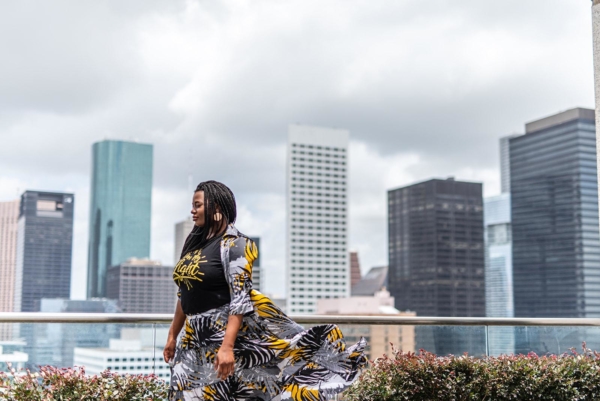
For the first time, she felt like a warrior––a woman empowered by her own voice.
Unfortunately, after graduation, Teonna’s red blood cell counts continued to tank. Tests revealed her bone marrow was not producing adequate numbers of red blood cells. Doctors advised her not to go to college. “I was devastated. I was 18 and watched all my friends go to college.” In the depths of her frustration, a bit of hope arrived. Doctors recommended a new treatment––a bone marrow transplant—which would allow her body to produce the healthy blood of a donor rather than her own. She waited months for a transplant match, but a phone call never came. “My mom heard of a clinical trial that used half-matches. All parents are half-matches.” The possibility was intriguing. Three out of Teonna’s four consulting doctors felt it was too risky because of the health complications it could cause. “But the fourth doctor said, ‘Let’s do this and do it now.’” Teonna decided to go for it, despite the risks. “We prayed. We taped up sentences from scripture and positive affirmations all over the wall in the hospital room.” Teonna knew she would lose her hair during treatment and a breast cancer survivor at the hospital volunteered to shave her head. In the mirror, Teonna saw a person she didn’t recognize. The survivor bent close to her ear. “You can do this,” she said.
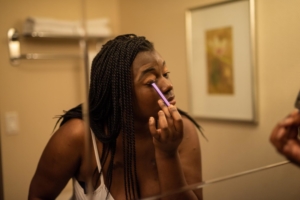 Teonna stayed in the hospital for a month enduring chemotherapy and radiation to help her body accept the transplant. One morning the doctor came in and told her there was bad news. The transplant had failed. “He told me my body hadn’t accepted any of it. He was so upset that even though he needed to catch a plane, he didn’t want to leave me.” Eventually he left the room in silence. The other doctors and nurses and her grandparents followed him out the door. Alone with her mom, Teonna broke down. They held each other in the hospital bed and wept in each other’s arms. “I struggled with God then. I felt like he was neglecting me.”
Teonna stayed in the hospital for a month enduring chemotherapy and radiation to help her body accept the transplant. One morning the doctor came in and told her there was bad news. The transplant had failed. “He told me my body hadn’t accepted any of it. He was so upset that even though he needed to catch a plane, he didn’t want to leave me.” Eventually he left the room in silence. The other doctors and nurses and her grandparents followed him out the door. Alone with her mom, Teonna broke down. They held each other in the hospital bed and wept in each other’s arms. “I struggled with God then. I felt like he was neglecting me.”
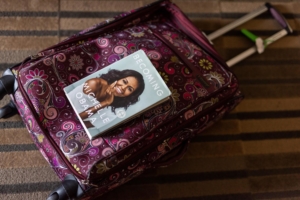 The doctor urged Teonna to make a last-ditch attempt by trying the transplant again. It was a daunting prospect. She had been through so much––pain, infections, and side effects from chemotherapy and radiation. The doctor told her if she didn’t do anything, she would die. “I couldn’t do it,” she says. “It was just too much to go through again. I told God he needed to step in and he did. Five months later, her bone marrow recovered on its own. “That was both amazing and difficult to accept. Many of my friends who went through a failed transplant have died.”
The doctor urged Teonna to make a last-ditch attempt by trying the transplant again. It was a daunting prospect. She had been through so much––pain, infections, and side effects from chemotherapy and radiation. The doctor told her if she didn’t do anything, she would die. “I couldn’t do it,” she says. “It was just too much to go through again. I told God he needed to step in and he did. Five months later, her bone marrow recovered on its own. “That was both amazing and difficult to accept. Many of my friends who went through a failed transplant have died.”
Teonna’s work in advocacy is her way of honoring those who have passed and working for better treatment options for the sickle cell warriors who live. She speaks on panels about her transplant process and spreads information to sickle cell patients about new clinical trial options. “I want to improve communication and trust between doctors and sickle cell patients,” she says. Noting the time, she realizes she needs to return to the work she is so passionate about. She packs her rolling suitcase with dozens of pamphlets, notebooks, her laptop, brochures, and business cards. Wheeling the heavy luggage behind her, she opens the door swiftly, undaunted by the future that lies ahead. “I’m spreading the word,” she says. “I have a lot of hope. In spite of everything, I am still able to smile.”
